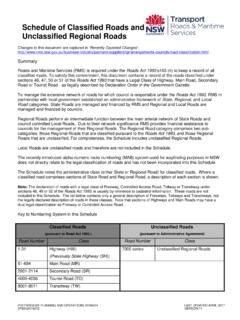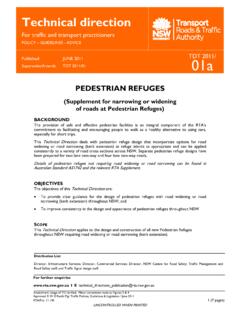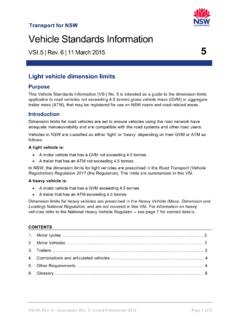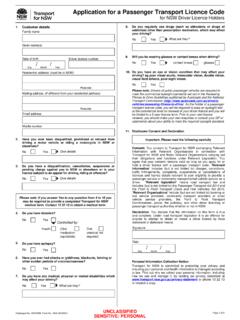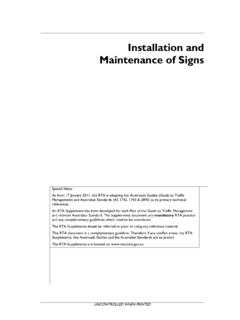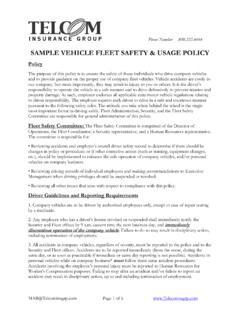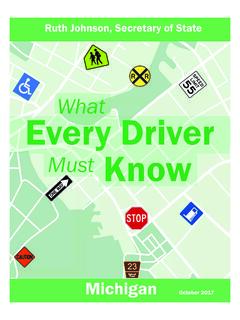Transcription of Speeding fact sheet 4 - How does speeding increase the ...
1 Speeding - Did you know? FACT sheet 4 of 6. How does Speeding increase the chances and severity of a crash? 1. What is Speeding ? How big a factor is Speeding in serious and fatal crashes? Speeding - which encompasses excessive speed (ie, driving above the speed limits ) or inappropriate speed (driving too fast for the prevailing conditions) - is unquestionably recognised as a major contributory factor in both the number and severity of traffic crashes (World Health Organisation, 2008) i . As a vehicle's speed increases, so does the distance travelled during the driver's reaction time (reaction distance) and the distance needed to stop (braking distance). Also, the higher the speed , the greater the amount of kinetic (moving) energy that must be absorbed by the impact in a crash. Therefore, as well as being identified as a causal factor in around 40 per cent of fatal crashes, speed is an aggravating factor in the severity of all crashes (See Crash Statistics on the RTA website.)
2 2. What is a driver's reaction time and braking distance? Reaction time is how long a driver takes to see both a hazard and the time it takes the brain to realise the danger and process a reaction to a hazard for example, starting to brake. The braking distance is the distance that a vehicle travels while slowing to a complete stop. As your speed increases - so does the distance you travel while your brain is processing information and reacting to it and so does the distance you need to stop. The average time it takes for most drivers to react to a risky situation on the road is seconds. A driver who is fatigued or distracted (eg, using a mobile phone or affected by drugs or alcohol) may take as long as three critical seconds to react. 3. How does speed contribute to the increased risk and severity having a crash? speed will increase both the reaction distance, and the braking distance. A driver travelling at faster speeds will have covered more ground in between spotting and reacting to a hazard than a driver travelling at a slower speed , so the Speeding driver is more likely to crash.
3 speed is also a major contributory factor to the severity of a crash. Consider this example: Two cars of equal weight and braking ability are travelling along the same road . Car 1, travelling at 60 km/h, is overtaking Car 2, which is travelling at 50 km/h. A child on a bicycle let's call him Sam emerges from a driveway 29 metres away just as the two cars are side-by-side. The drivers both see Sam at the same time and both take seconds before they fully apply their brakes. In the few moments it takes to react and stop, Car 2 would have had enough space in which to stop without hitting Sam. Car 1, on the other hand, would be travelling at 44 km/h when it hits Sam and at this speed , it is highly likely that Car 1 would have seriously injured or even killed Sam. Speeding also contributes to the increased risk of losing vehicle control. At higher speeds, cars become more difficult to manoeuvre - especially on corners or curves or where evasive action is necessary.
4 Roads and Traffic Authority of New South Wales | 13 22 13 July 11. RTA/Pub. 4. What is kinetic energy? How does it relate to speed ? The kinetic energy of a moving vehicle is a function of its mass and velocity squared and this energy must be absorbed in a collision by friction, heat, and the damage suffered by the vehicle as a result of the crash. This means, the more kinetic energy to be absorbed in a collision, the greater the potential for injury to vehicle occupants and anyone hit by the vehicle. Because kinetic energy is determined by the square of the vehicle's speed , rather than by speed alone, the probability of injury, and the severity of injuries that occur in a crash, rapidly becomes greater with vehicle speed . For example, a 30 per cent increase in speed (eg, 80 to 105 km/h) results in a 69 per cent increase in the kinetic energy of a vehicle more than doubling the probability of injuries occurring and their likely severity.
5 5. Where does kinetic energy go during a crash? Following a crash involving a vehicle hitting an object (vehicle, tree, pedestrian, etc), the vehicle eventually comes to rest. Some of the kinetic energy is absorbed by your vehicle (which is why your car is damaged) and some is transferred to the object you hit. For example, a car travelling at 65 km/h will have a force of about 87 tonnes to be absorbed in a crash compared to a force of 74 tonnes needed to be absorbed by the car travelling at 60 km/h. 6. Does lowering speed limits really help decrease the risk and severity of a crash? Current and past research in Australia and internationally provides compelling evidence that increased travel speeds even at low levels are directly related to both the likelihood of a crash occurring and to the severity of crash outcomes. Many researchers (Woolley) ii have demonstrated that lower travel speeds and death tolls usually follow lowering of speed limits and higher travel speeds and death tolls follow increases in speed limits .
6 During the 1970's energy crisis, the maximum speed limit was reduced across the United States of America (USA) from 70 miles per hour (113. km/h) to 55 miles per hour (89 m/h) and the National Highway Traffic safety Administration board issued a special report, pointing out that this reduction in maximum speed had resulted in a percent drop in fatalities. In 1987, the USA lifted the speed limit on rural interstates to 65 miles per hour (105 km/h), which led to a 17 per cent rise in fatalities. A report appearing in the American Journal of Public Health in 2009 has found that a per cent increase in road fatalities was attributable to the raised speed limits on all road types in the United States, resulting in 12,500 more deaths between 1995 and 2005. In 1987, Victoria raised the speed limit on its rural and outer Melbourne freeway network to 110 km/h from 100. km/h. There followed an increase in casualties (including fatalities) of per cent.
7 In late September 1989, a 100. km/h limit was reintroduced, resulting in a reduction in crashes of per cent (Sliogeris, 1992) iii . In NSW, recent experience shows that reducing speed limits is an effective measure in reducing the number and severity of crashes including the 26 per cent reduction in casualty crashes on the Great Western Highway after speed limits were reduced from 110 to 100 km/h (Bhatnagar et al) iv . 7. How does Speeding increase the injury or death risks to pedestrians and other road users? In addition to car occupants, our roads are used by many road users including pedestrians, motorcycle and bicycle riders, who are more vulnerable to injury or death if hit by a Speeding vehicle. Studies of the relationship between the survival of a vulnerable road user and vehicle impact speed (the speed at which the vehicle was travelling when it hit the vulnerable road user) show that small increases in travel speed can result in large increases in braking distances and impact speed - substantially increasing the risk of a pedestrian, motorcycle, bicycle rider, or baby in a pram being killed or seriously injured.
8 Let's take the example of Sam the bicycle rider in Question 3. If Car 1, travelling at 50 km/h, brakes when Sam is 29 meters away, there will be enough space in which to stop without hitting Sam. If Car 2 is travelling at 60 km/h, when Sam is 29 meters away and the driver brakes at the same point, Car 2 will be travelling at 44 km/h when it hits Sam. Roads and Traffic Authority of New South Wales | 13 22 13 July 11. RTA/Pub. Consistent with this, slight reductions in vehicle speed will significantly reduce the severity of outcomes for pedestrians in the event of a crash. Drivers are twice as likely to kill a pedestrian if they are travelling at 50 km/h than if they are travelling at 40 km/h (see diagram below from Waltz et al). v . 8. Does it make a difference if a vehicle is hit from the front or side? In addition to speed greatly increasing the risk of severe or fatal injuries, a number of studies show that side impact or t-bone' crashes are only survivable by passengers in a vehicle at much lower speeds than frontal crashes.
9 This means that controlling speed at intersections is critical, to reducing crashes and casualties in areas where this type of conflict may occur. 9. Who's more dangerous? The high number of people who speed by a small margin - or the small number of dangerous drivers who sometimes speed excessively? High level Speeding places that driver and other road users or passengers at great danger, however low level Speeding is an extremely dangerous community wide issue due to the large number of drivers who speed by a small margin. In urban areas, exceeding the speed limit by 5 km/h doubles the likelihood of a casualty crash and each additional increase in speed by 5 km/h further doubles the risk (Kloeden et al) vi . Low level Speeding is such a large issue because the cumulative effect of the additional risk associated with low level Speeding multiplied by a high number of drivers Speeding at these low levels, results in more casualty crashes than high level Speeding (Gavin et al) vii.
10 10. More information/contact details For more information on speed zones and to Have Your Say' on speed limits and speed limit signs, visit the RTA's new Safer Roads NSW website at References: i World Health Organisation (WHO) (2008), speed management: a road safety manual for decision-makers and practitioners, Geneva, Global road safety Partnership. ii Woolley J, Recent advantages of lower speed limits in Australia, Journal of the Eastern Asia Society for Transportation Studies, Vol. 6, pp. 3562 - 3573, 2005. Roads and Traffic Authority of New South Wales | 13 22 13 July 11. RTA/Pub. iiiSliogeris, J. 110 Kilometre Per Hour speed Limit - Evaluation of road safety Effects. Report No: GR 92 - 8. VicRoads. iv Bhatnagar Y, Saffron D, de Roos M and Graham A (2010), Changes to speed limits and crash outcome Great Western Highway case study, 2010 road safety Research, Education and Policing Conference, Canberra, v Waltz, F.

